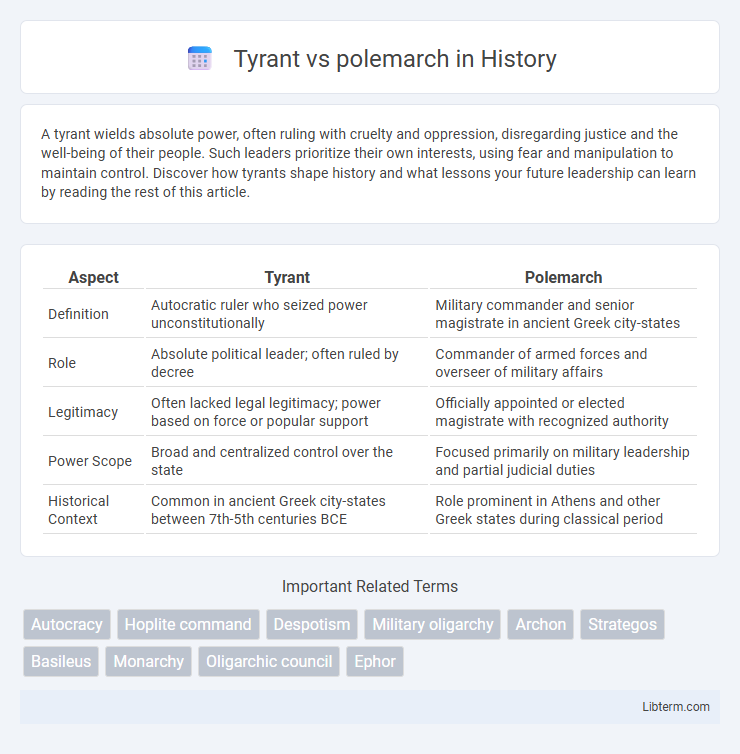A tyrant wields absolute power, often ruling with cruelty and oppression, disregarding justice and the well-being of their people. Such leaders prioritize their own interests, using fear and manipulation to maintain control. Discover how tyrants shape history and what lessons your future leadership can learn by reading the rest of this article.
Table of Comparison
| Aspect | Tyrant | Polemarch |
|---|---|---|
| Definition | Autocratic ruler who seized power unconstitutionally | Military commander and senior magistrate in ancient Greek city-states |
| Role | Absolute political leader; often ruled by decree | Commander of armed forces and overseer of military affairs |
| Legitimacy | Often lacked legal legitimacy; power based on force or popular support | Officially appointed or elected magistrate with recognized authority |
| Power Scope | Broad and centralized control over the state | Focused primarily on military leadership and partial judicial duties |
| Historical Context | Common in ancient Greek city-states between 7th-5th centuries BCE | Role prominent in Athens and other Greek states during classical period |
Defining Tyrant and Polemarch
A tyrant in ancient Greek context referred to an individual who seized power unconstitutionally, ruling with absolute authority often without regard for legal or traditional constraints. In contrast, a polemarch originally served as a military commander and later took on judicial and political responsibilities within the polis, representing lawful authority and protection of the community. The defining difference lies in the tyrant's usurpation of power versus the polemarch's role as a sanctioned leader within established governance structures.
Historical Context: Origins and Roles
Tyrants in ancient Greece emerged during the 7th and 6th centuries BCE as rulers who seized power without legal right, often supported by popular factions dissatisfied with aristocratic rule. Polemarchs originally served as military commanders and senior magistrates in city-states such as Athens and Sparta, responsible for leading armies and overseeing warfare. The transition from polemarch authority to tyrannical rule reflects shifts in political structures as tyrants often bypassed traditional institutions dominated by aristocrats and military leaders.
Power Structure: Authority and Governance
A tyrant centralizes authority through autocratic control, often bypassing existing legal frameworks to maintain absolute power. In contrast, a polemarch operates within a more structured governance system, typically as a military commander under the state's hierarchy. The tyrant's governance is characterized by unilateral decision-making, while a polemarch's authority is limited and subject to the state's constitutional or institutional laws.
Political Influence and Control
Tyrants wielded absolute political influence through centralized power, often seizing control by populist support or force, overriding traditional laws and aristocratic authority. Polemarchs held limited political influence, primarily serving as military commanders with authority rooted in established legal frameworks and often subordinate to broader governmental institutions. The tyrant's control disrupted existing power structures, while the polemarch's role maintained and enforced the political order within the state.
Military Leadership and Responsibilities
A tyrant in ancient Greek city-states often held absolute power, using military force to establish and maintain control, frequently commanding their own armies or mercenaries to enforce authority. In contrast, a polemarch was a designated military commander responsible for leading the city's hoplite forces in battle and overseeing military organization and strategy without holding unchecked political power. While tyrants combined political and military leadership, polemarchs functioned primarily as appointed military officials focused on defense and warfare execution.
Legal Framework and Accountability
A tyrant operates outside established legal frameworks, wielding power through arbitrary rule and personal decree without formal accountability mechanisms. In contrast, a polemarch traditionally functions within a defined legal system, often accountable to laws and communal assemblies that regulate military and civic duties. The polemarch's authority is subject to legal constraints and oversight, ensuring a structured balance of power absent in tyrannical governance.
Public Perception and Legitimacy
Tyrants often rise to power through unconventional means, leading to negative public perception and questions about their legitimacy, as their rule typically bypasses established legal frameworks. Polemarchs, traditionally military commanders within Greek city-states, derive legitimacy from their official roles and community support, fostering more positive public acceptance. The stark contrast in their perceived legitimacy influences their ability to govern and maintain social order effectively.
Case Studies: Famous Tyrants and Polemarchs
Famous tyrants such as Pisistratus of Athens and Dionysius I of Syracuse demonstrate how absolute power was often seized through force or manipulation, reshaping political landscapes with centralized control. In contrast, notable polemarchs like Miltiades the Elder of Athens wielded military authority with a focus on defense and strategic leadership within the polis, balancing civic duties and military command. Case studies reveal tyrants prioritized personal dominance and political stability through autocracy, while polemarchs maintained order through martial responsibility and legal enforcement.
Impact on Society and Civilization
Tyrants centralized power through autocratic rule, often disrupting traditional social structures and imposing order via fear, which led to both social instability and moments of reform in ancient city-states. Polemarchs, as military leaders and guardians of civic order, maintained established aristocratic hierarchies and protected societal norms, reinforcing stability and continuity within the polis. The contrasting governance styles shaped the evolution of political systems, with tyrants sometimes catalyzing shifts towards democracy while polemarchs upheld institutional continuity and civic identity.
Tyrant vs Polemarch: Key Differences and Legacy
Tyrants and polemarchs held distinct roles in ancient Greek governance, with tyrants seizing power through unconventional means often backed by popular support, while polemarchs served as military commanders elected or appointed within established political structures. The legacy of tyrants is marked by their temporary autocratic rule, which sometimes led to political reform or upheaval, contrasting with polemarchs whose authority remained tied to military and civic duties within the polis. Understanding these differences reveals the evolution of political power and military leadership in classical Greece, highlighting how tyranny challenged traditional oligarchic and aristocratic governance.
Tyrant Infographic

 libterm.com
libterm.com